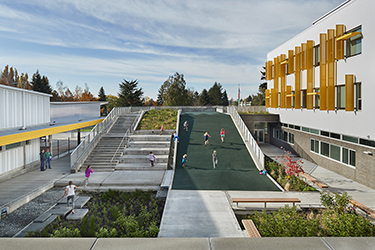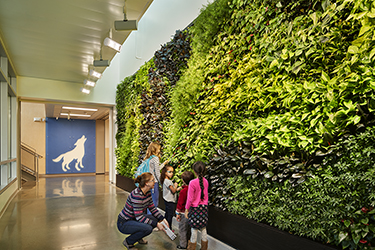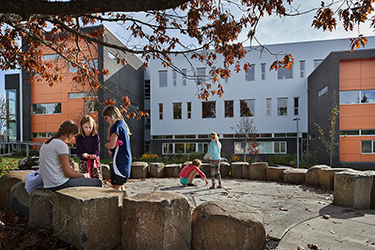|
Subscribe / Renew |
|
|
Contact Us |
|
| ► Subscribe to our Free Weekly Newsletter | |
| home | Welcome, sign in or click here to subscribe. | login |
Environment
| |
 |
March 23, 2017
‘Biophilic’ design bonds children with nature
NAC Architecture

Kazmierczak
|
A significant gap exists between the natural and built worlds. All too often, buildings are designed with a certain separation — the edifice itself is seen as one entity while its surrounding landscape is viewed as something entirely different.
Over time, this chasm has negatively impacted both humans and the environment. With a greater emphasis placed on having the latest devices, children in particular are caught up in this artificial, electronic world of technology. Sensory development in humans often begins with exposure to the outdoors, and today’s children are losing out on this critical element of healthy growth.
The positive effect of nature on children is a recurring topic in educational research. Numerous studies reveal that direct exposure to natural elements has beneficial outcomes in a child’s ability to learn and grow.
One such example is from Richard Louv, author of the best-seller “Last Child in the Woods.” In his book, Louv cites case studies of preschool-aged children in Sweden and Norway who played on either flat playgrounds or uneven natural terrain. After one year, the children who played in the more natural locations exhibited better motor skills than their counterparts.
However, despite a demonstrated need for a strong connection to nature, it remains a challenge for most schools to incorporate natural outdoor space into their programs. Now that we know there exists a problem, just how do we go about addressing it? The answer is in our DNA.
Life-loving design
In 1984, biologist and Harvard University professor Edward O. Wilson published his book “Biophilia,” which coined the title term meaning, “the innate tendency to focus on life and the lifelike processes.”
Etymologically, biophilia comes from the Greek “bios,” meaning life, and “philia,” meaning fondness. As a field biologist specializing in the behavior of ants, Wilson combined his scientific knowledge with his keen sense for the human condition, ultimately arriving at his theory of biophilia.
Further studies and research involving biophilia have led to an entirely new field of design, aptly named “biophilic design.”
In 2008, Yale professor Stephen R. Kellert published a book by this very title, in which he stated that biophilic design is “an innovative approach that emphasizes the necessity of maintaining, enhancing, and restoring the beneficial experience of nature in the built environment.”
He further explains that this innate love of nature within humans is actually an essential part of our development and maturation as a species, deeply embedded in our genetic code.
Biophilia in schools
This idea of human development and maturation speaks directly to the need to incorporate this design methodology in early childhood education spaces. How exactly can schools go about doing this? Various sources suggest ways to implement biophilic design principles to support a nature-based curriculum, as well as foster positive developmental responses from students.
Kellert details over 70 biophilic design elements that can be used to greatly enhance a user’s experience of built space. At NAC Architecture, we have incorporated many of these elements into our own pre-K-12 projects.
A recent project, the Hazel Wolf K-8 E-STEM School for Seattle Public Schools, demonstrates biophilic design principles such as environmental features, exploration and discovery, views and vistas, bounded spaces and spatial variability:
• Environmental features from the outdoors are brought in via a living wall. Two of the vertical panels are independently set up for light and water so students can conduct investigations; one panel serves as the control while the other can have its features manipulated.
• Experiential learning is linked to the real world through exploration and discovery where a rain garden gives students the opportunity to investigate important questions: What types of plants and animals use this water filtering feature? How does it change over time? How does a rain garden filter rainwater?
• Views of natural surroundings lead to students’ greater appreciation for the environment. The incorporation of extensive clear glass offers scenes of the outdoor environment, making nature an essential and daily part of students’ lives.
• Students sense security in the outdoors in the bounded spaces created by the school’s learning courtyard, offering the opportunity to experience the outside environment while still providing a feeling of safety and refuge.
• Spatial variability is created where the topography functions as a playground; a grass slope in the school’s courtyard works as a natural play structure, allowing students to create their own uses for the landscape.
The amount of science on the topic of biophilia as it relates to early childhood education makes it difficult to ignore. As such, it is critical that we continue taking steps to implement design methods that encourage students’ beneficial engagement with the natural environment.
Laura Kazmierczak brings a user-centric design approach to NAC’s education projects, focusing on students’ interactions with their learning environments. NAC Architecture is an award-winning design firm with offices in Seattle, Spokane and Los Angeles.
Other Stories:
- 2 state bills would reward owners who green up their buildings
- How 'negawatts' help the building industry fight climate change
- Next frontier for sustainability? The people inside all those green buildings
- 4 strategies to make office workers healthier and more productive
- Eco-friendly transfer station adds playground to be a good neighbor
- Georgia Tech wants a Living Building, but can designers beat the heat?
- Sweat the details to make building green pay off
- 12 Bel-Red townhouses help restore a trashed site





